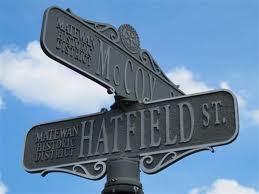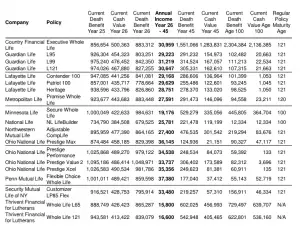The debate between direct recognition and non-direct recognition is a long-standing one. Be sure to review both of our earlier posts on these topics for more in-depth explanations.
So, which is the superior method of treating dividends when there’s an outstanding policy loan?
Are the “purests” correct when they point to non-direct recognition as the only way a company should approach whole life policy loans?
Or, does direct recognition have an advantage by “not subsidizing the policies with loans with the ones without them” as the companies that issue direct recognition contracts are quick to point out?
The Non-Direct Approach
As we’ve said, non-direct recognition does not adjust the dividends paid on a policy when there is an outstanding policy loan. For a long time, this has been regarded as a superior feature. We’ve covered the notion that policy loans do not come out of the policy.
And, in truth, whether the policy is direct recognition or non-direct recognition, something still gets paid on the cash values that are pledged as loan collateral.
This feature has been the catalyst behind numerous marketing packages mentioned in the non-direct recognition post. The addition of non-direct recognition augments this benefit, or so the claim goes.
But, one question non-direct recognition adherents often fail to address is that there is no fix-all.
The likes of MassMutual, New York Life, Ohio National, and MetLife (some big names in the non-direct arena) do not have access to a magic well from which to pull money.
So, while it’s very nice that they don’t adjust dividends, there has to be something that they give up in order to make that benefit a reality.
The Direct Approach
Direct recognition, as we know from the last post, was introduced as a way to combat rising interest rates that made whole life insurance policies of the day appear to dramatically lag behind other fixed income-based assets.
Direct recognition companies are quick to point out that their non-direct counterparts are subsidizing policies with loans with policies that do not take loans. In other words, they are dragging down the dividend they could be paying non-loaned policies to prop up the loaned policies.
This seems like a fair criticism, but some non-direct recognition companies would counter that the practice of “subsidizing” the dividend with other business units is a prevalent practice among all companies.
For example, a company may derive a significant amount of income from a non-participating block of insurance business.
Profitability on this block is not shared with policy owners and instead is part of the company’s surplus goes towards whole life dividends.
Traditionally, direct recognition has been criticized by its opponents for reducing the dividend rate when a policy loan is outstanding.
However, since fixed loan interest rates on some policies are currently higher than insurance companies are earning on their general account investments, direct recognition has turned into a feature that increases dividends paid on loaned portions of policies.
Keep in mind that whole life is a product issued mostly by mutual life insurers who seriously consider participating policyholders as owners and that the company works to deliver the best benefits to its owners.
It’s important to note that this practice (increasing dividends) does not enhance policy performance by virtue of taking a loan as there is still a spread between loan interest and the dividends paid.
It does, however, offset what in current conditions might seem like very high interest rates.
It’s Really No Contest
When it comes down to it, one is not superior to the other. All this talk about direct recognition vs. non-direct recognition is a game of smoke and mirrors used to keep your focus away from the really important stuff.
In the fight among insurance companies, there is no magic, but there are plenty of magicians.
There are good and bad direct recognition and non-direct recognition contracts.
I’ve talked about the Blease projected income report, which is done every year by Blease/Full-Disclosure (edit: Blease Research is no longer updated due to the passing of its founder, Roger Blease, in 2013).
This report solves for death benefit based on a specified base premium for several companies and then solves for projected income. If you want to read the article on the Insurance Pro Blog, it can be found here.
Here’s an image taken from the current report that shows us all of the participating companies and their results:
Click on the Picture to Enlarge
Now, if non-direct recognition were the ultimate feature, then the non-direct recognition companies should consistently report higher incomes, but that’s not the case.
Ohio National (a non-direct recognition company) does take second place, but Penn Mutual (a direct recognition company) wins top prize.
Also note that we have to cut through Security Mutual, the Guardian, and Country Financial (all direct recognition) before we get to another non-direct recognition company: Lafayette Life.
It is noteworthy that both Mass Mutual and New York Life are missing from this list. We suspect Mass could give Penn Mutual a run for its money. New York Life, on the other hand, probably isn’t going to win this fight.
Details, Details, Details
I said it at the beginning of this post, and I’ll say again – there’s more to a whole life contract than its dividend recognition.
The total package is important, so if you’re looking at one product simply because it is or isn’t non-direct recognition, you may be under the influence of a magician.
Direct recognition is more prevalent but can also have some pitfalls (note that the worst performers tend to be direct recognition contracts).
Life insurance contracts can be robust. Be sure to consider wealth accumulation and retirement income strategies when making a life insurance purchase as opposed to getting hung up on whether the contract is direct or non-direct recognition.
Feel free to reach out to us if you have any questions. We can help you objectively evaluate which policy will work best for you using our own proprietary analysis.






There’s an important extra point to make. If someone has good credit, and a substantial cash value with a Direct Recognition company, they actually have the option of going either way, as follows:
1. They can borrow directly from the company at a fixed rate, or
2. They can pledge their policy as collateral and borrow from a bank or other lender at a variable market rate.
If interest rates turn the other way (up) and loan is still needed, strategy can be reversed.
On the other hand a policy with a variable rate still bears interest rate risk on the policy loan.
Furthermore, income illustrations are more reliable with direct recognition, as the loan interest rate is KNOWN as is the related dividend on the loaned amount. With non-direct recognition loan we can see dividend interest rates and loan rates go in opposite direction (as NYL did a while ago on their older series Whole Life – I know because I own several NYL policies with loans. I also own several Guardian policies with loans.)
Hi Oren,
Thanks for bringing this up
We’ve actually done collateral assignments for both direct and non-direct recognition policies in the past. It’s not a terrible strategy, though at times the fees assessed against loans of this nature from the bank seem a tad excessive.
I’m not sure I’m in complete agreement about direct recognition being more reliable on income per se. Yes the loan rate is fixed, but there are a number of direct recognition companies that do not fix the dividend rate when a loan is outstanding. Guardian, for example, has a current practice regarding what happens to the dividends when there is a loan that is very nice, but it’s not a guaranteed feature to the products.
We’re still very much of the opinion that this feature alone should never be the deciding factor. There are more pieces and parts to look at before making a decision.
Brandon,
Rather late response, but I think you’re missing one point about the Guardian practice:
Since this is part of a dividend calculation, by definition this can never be guaranteed, as dividends are NEVER guaranteed.
The only way I can imagine a company like Guardian would reverse its practice would be if things got so bad with portfolio rates, that they would want to subsidize them with the loan income. Non-direct recognition companies already do that now.
Let’s remember that policy loans are an asset on the insurance company’s balance sheet, and since it’s earning a certain guaranteed rate (in the case of direct-recognition) or a company determined rate (in the case of non-direct-recognition), and has a 0 risk of default, it’s an extremely profitable asset to the insurance company.
In any event the fixed loan rate is guaranteed, and provides some certainty. With a non-direct recognition company, the loan rate is not guaranteed and doesn’t have a cap (to the best of my knowledge).
In any event, these are two different approaches which were taken when interest rates skyrocketed. I would guess that at the time of implementation no-one fathomed the current interest rate environment.
Hi Oren,
My point about the non-guaranteed nature of Guardian’s approach was simply to point out that your claim about direct recognition being more accurate for income scenarios because there is a known loan rate and known relative rate for the dividend wasn’t 100% true.
The Blease report can be very deceiving because it focuses on a death benefit only as it’s starting point, but the premiums are much different from carrier to carrier. With that, the higher premium products will have more cash growth, less leverage on death benefit. If you fund a policy with a matching premium among all carriers and same initial death benefit using the highest contract premium in the bunch and funding the lower premium policies with excess going to paid up additions, you will see a much different result. This is a more accurate level playing field.
Jeff makes a good point. Can you provide a new analysis with his suggestions in mind?
No actually Jeff’s point was very off base in terms of its criticism as Blease had numerous reports that compared things like internal rate of return (IRR) and also solved death benefit for premium keeping the outlay even across carriers. We only used that comparison as supporting evidence of our point, and not definitive evidence.
That being said, we’ve provided numerous other comparisons that also speak to this issue in the competitive analysis section of the Insurance Pro Blog.
You may have addressed this and I missed it, but…what happens if you take a loan from a PUA and do not pay it back? Dividends still get paid but…how/when does the company get the money back? if ever?
Hi Catherine,
The insurance company would get back money upon death by collecting the loan balance from the total death benefit. The total death benefit equals both the base whole life death benefit and the death benefit created by PUA’s.
If the contract were surrendered, the insurance company would simple deduct the loan balance from the total cash value.
Hey, thanks for all the info on this blog. Could you go into more detail on the actual loan cost, for example in a NML vs MML policy. Currently NML is 8% fixed and appears to have a -.55% spread. I am really confused about the true cost of a MML policy loan though, it is 5% variable, but I assume they would not allow a situation where you had a positive spread, or a complete wash. Usually MML agents (most not all) say they can generate more income than a NML every time. Thanks!
Hi AJ,
The problem for both is that they typically compare the dividend interest rate vs. the loan interest rate, and the dividend interest rate is not necessarily entirely paid against the cash value of the policy. For example, MassMutual does have a 5% loan rate (currently) and a 7.1% dividend interest rate. One might infer this means that they charge 5% on loans while paying 7.1% on the cash; this is not exactly true. The dividend interest rate is applied to the policy’s reserve which can be close to but not exactly the same as the cash value. In addition, there are various expenses applied to the total dividend payout that are not included in MassMutual’s 7.1% dividend (i.e. MassMutual is telling you what rate they are using as part of their calculation, but that’s only one step in the process).
The same can be said (in certain circumstances) for Northwestern. The dividend interest rate is only a component of the dividend payout and–unlike most of their competition–not the largest component.
The exact comparison for expenses cannot be ascertained since the information needed to do that is considered proprietary and neither company will disclose. We can, however, infer that MassMutual tends to be the better deal for the consumer given their projections for income distributions.
I can’t say that they will always absolutely beat out Northwestern in an income scenario since such a claim is without adequate substantiation, but I can say that I’ve compared the two numerous times and Northwestern has never been the winner.
Thanks for your reply. So, I guess hard to say the true cost of a Mass loan?
One more question, is there any other third party research on cash value whole life insurance? It seems like each carrier such as NML take only part of a report and leave other parts out, you would think that would be illegal.
How do I get on your mailing list or subscribe to your blog?
Hi James, thanks for reaching out. I’ve added you to our subscriber list, let me know if we can do anything else to help!
I am not sure where you got your information from by Country Financial is a non-direct recognition company.
Uh… the penalty is the interest rate on the CV loan. I think that non-Direct is far superior and easily justified in the fact that the loans cost the borrower to make up the difference. There is no expense for those with policies that do not borrow. I think that Direct recognition loan companies are not being honest here.
vRico,
While that’s an establish theory about NDR versus DR, my experience leads me to believe it’s far more nuanced than you’re letting on. We’ve discussed this at length here and elsewhere.
Hi Mr. Roberts,
I appreciate all of the info you are sharing on your blog (as I am just discovering the page). Do you have any blogs in regards to direct vs. non-direct when it comes to someone constantly utilizing the loan mechanisms available to them. I’m thinking of a business owner that wants to set up his or her personal “infinite banking” system.
In this type of situation have you seen how one performs compared to the other?
Thank you in advance,
Erik
Hi Erik,
We went through such a scenario in the Dividend Recognition Webinar we did a little while back. It’s part of the book we wrote Predictable Profits, you can check it out here: Predictable Profits
I would like to subscribe to your blog.
Hi K, You can do that through the sign-up form found on the homepage.